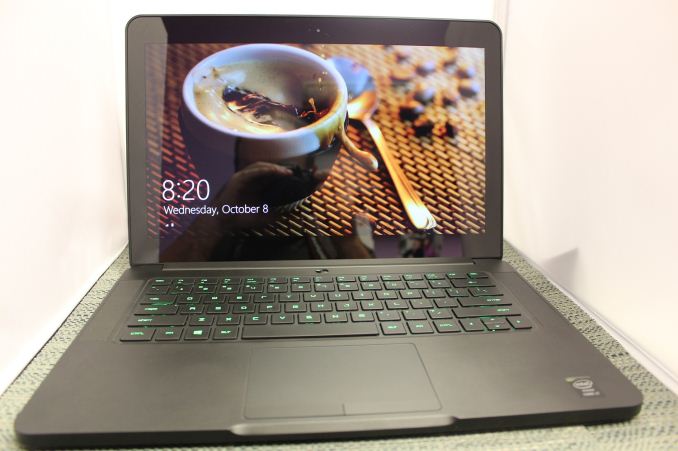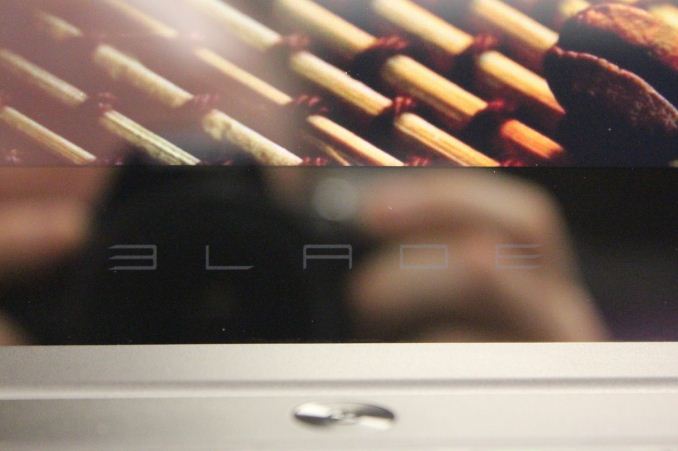The 2014 Razer Blade Review
by Brett Howse on October 10, 2014 9:00 AM EST- Posted in
- Notebooks
- Gaming
- Laptops
- Razer Blade
Final Words
The 2013 Razer Blade was a fantastic notebook computer with an abysmal display. For 2014, Razer has put one of the best displays we have ever tested in a laptop into the Blade, and it truly completes the experience. Razer’s slogan is “For Gamers, by Gamers” and we have to first evaluate the Razer Blade as a gaming laptop. Here it succeeds almost completely.
With a quad-core Intel Core i7 and an NVIDIA GeForce GTX 870M, there is a lot of processing power. The 14 inch Blade runs with larger gaming systems in our benchmarks, and it does all of this without throttling under load. It does get hot, but for the most part it is not hot where you will be touching it.
The high PPI display also looks fantastic when gaming at the native resolution, but the 3200x1800 resolution certainly taxes the available GPU power, and in order to push almost 6 million pixels some of the effects in games will need to be turned down. Luckily this is generally a very easy process for a lot of games due to the GeForce Experience software. If the game you want to play is not in the NVIDIA database though, expect some trial and error to find a frame rate and graphical quality that works for you. Perhaps a 2015 refresh of the system with the GTX 970M will be the solution to this.
If you are looking for a powerful, portable, well-built gaming laptop, you would be hard pressed to find something more pleasing for the task. There are faster systems out there, but they are generally larger and heavier, so you would lose the portability of a 14 inch system. In the past, gaming laptops were meant to move from one table to another, but the Razer Blade has shown that this does not need to be the case.
Portability is one of the biggest aspects of the 2014 Razer Blade. The CNC aluminum body is thin and light. Yet inside is a 70 Wh battery that allows the Blade to be used unplugged from the mains for a reasonable amount of time. Battery life is not record setting, but considering the amount of performance inside and the high PPI display, it is generally adequate.
When you have a system of this quality and price, you have to assume no one is going to buy it just as a system to game on. As a general purpose PC, the Razer Blade is also very good. Performance is very quick due to the Samsung SSD, and the display once again is the star of the show with fantastic color reproduction and great viewing angles. The Blade looks and feels a lot like a 15 inch MacBook Pro, and likely by design.
The two machines both have high resolution displays, strong aluminum bodies, and the size and weight are so close the comparisons are unavoidable. But as a general use laptop, the rMBP does edge the Razer in some key areas. It has a faster CPU, it comes with a default of 512GB PCI-e based SSD, and most importantly it comes with 16GB of memory. The GPU is a much less potent GT 750M though, but for applications that is generally not such a big deal. I would have liked to see Razer bump the memory to 16GB, which would allow the Razer Blade to be used for many more tasks, especially running Virtual Machines.
While I would like to see the 16GB of memory, that does not detract from what is already there. Overall the Razer Blade is a fantastic laptop, with excellent build quality, great acoustics, a powerful CPU and GPU, and now, finally, an amazing display. The 2013 model was well reviewed despite the horrible display, due to the thin and light design. You can see the effort put into the 2014 model to ensure that the mistakes of the last model are rectified, and they certainly are.
The price has crept up a bit over last year though, with the base cost now at $2200 USD. But that is only with 128GB of storage, which really isn't sufficient , so most users will have to jump up to the $2400 USD 256GB model. That's expensive to be sure, but for the money you get one of the best notebooks with one of the best displays money can buy, even several months after launch.












69 Comments
View All Comments
lyeoh - Saturday, October 11, 2014 - link
What's the display and other IO latency? What tests did you use for your graphics ghosting test?Calista - Saturday, October 11, 2014 - link
Hi Brett!How well does the screen deal with gaming at non-native resolutions. A major advantage of high-dpi displays is obviously the fact it brings us closer to the way a CRT screens behave with fixed resolution all. With such high pixel density and a normal viewing distance of >60 cm I would expect also odd resolutions to look great in their own right.
Brett Howse - Sunday, October 12, 2014 - link
I only ran it at 1600x900 which is a perfect 2:1 interpolation, and it looked fine. Hard to say if it would be as good as a native 1600x900 panel but to my eyes, it looks good enough if you do need to run it at that resolution. Gaming at 3200x1800 was absolutely fantastic though it was an amazing experience. Everything is just so sharp.fancypr007 - Sunday, October 12, 2014 - link
What's funny is how the previous model used a 1600x900 TN panel screen and at the time the excuse Razer's CEO gave for using it vs using a superior IPS panel was; "this is a gaming laptop and we wanted to use the best screen for gaming."Now they're using a panel that for modern games, you'll never be able to push at anywhere near native resolutions with the included graphics card. Marketing doublespeak.
CaptainCupcakes - Thursday, October 30, 2014 - link
The reasoning for the new QHD+ display was to prove a point of what Razer is actually capable of. The logic behind last year's screen resolution was that if they used a screen that could not outpace their GPU, that the computer would have great performance. They answered the cry of the people with the new display.vol74 - Wednesday, October 15, 2014 - link
Best laptop I've ever owned. But Razer made one glaring oversight - they didn't provide a way to disable the trackpad. It's pretty aggravating when a stray thumb triggers it when gaming. Razer support recommended disabling it via the device manager. Unbelievable. Hey Razer, how about an option in Synapse to disable the trackpad when an external mouse is detected?HiTechObsessed - Wednesday, October 15, 2014 - link
Crazy expensive. You can get the CyberPowerPC thin-and-light with an 870m for $1100, and even has a slightly better CPU. This is ungodly expensive, for lower gaming performance.synaesthetic - Monday, October 20, 2014 - link
What's the point of that absurd resolution if the GPU can't even push games at 1920x1080 to a decent framerate? You're just going to have to play the games in 1600x900 anyway to get any kind of decent performance, so why bother with the super-high resolution panel if it's not even going to get used?The only logic I can detect behind this decision is that the resolution is exactly four times that of 1600x900 and would scale down to that resolution without interpolation.
ins1dious - Wednesday, November 5, 2014 - link
Seeing as how you compared the 2014 Blade to an rMBP on weight, build, battery etc... can you include the gaming scores for the rMBP as well? Obviously under bootcamp... curious as to how far behind the rMBP's 750M performance is